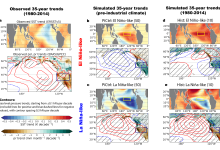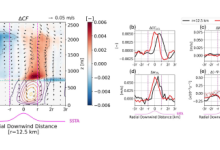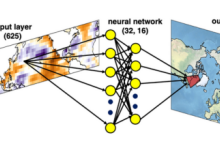Research Highlights
We aim to feature the latest research results from US scientists whose published paper features work that is sponsored by one or more sponsoring agency programs of US CLIVAR (NASA, NOAA, NSF, DOE, ONR). Check out the collection of research highlights below and sort by topic on the right. Interested in submitting an article for consideration? See our Research Highlight Submission Guidelines page for more information.
If you have been to the Southwestern US (SWUS), you know how precious every drop of water is. Summers are hot and dry, and the water resource of this region relies heavily on precipitation in winter and spring. When precipitation doesn’t come, drought can develop quickly and create remarkable socio-economic impacts. “Why has the SWUS precipitation declined since the 1980s?” becomes a puzzle to solve (Figure 1a). Kuo et al. (2025) revisited this attribution of post-1980 SWUS precipitation decline to internal decadal variability, and they showed that anthropogenic emissions have contributed to this decline.
Chen et al. (2025) employs large-eddy simulations to demonstrate how small-scale SST variations can increase trade cumulus cloud formation. The authors argue that locally enhanced convective updrafts lead to an increase in cloudiness near the cloud base, which occurs downwind of the maximum SST warm anomaly as the SST anomaly gets sharper. Their results suggest that improving model parameterizations could reduce uncertainty in climate models by better capturing how subcloud turbulent mixing, convective mass flux, and cloud-base cloudiness respond to small-scale SST anomalies in the tropical oceans.
Published in Journal of Climate, Karnauskas (2025) re-examined a collection of historical estimates made since 1961, as well as drifters and other modern observations and state estimates, to provide new constraints on this key variable.
Shackelford et al. (2025) present a framework for identifying state-dependent prediction skill using neural networks and self-organizing maps (SOMs), and offer an example application to prediction of North Atlantic atmospheric circulation.
Larson and McMonigal (2025) analyze two climate model ensemble experiments, one with internal WDOC variability and one without, to determine how much ocean circulation variability impacts when anthropogenic SST signals emerge. They find that overall, internal WDOC variability delays the time of emergence of anthropogenic SST signals everywhere, with the longest delays occurring in the global tropics and other dynamically active regions of the ocean.





